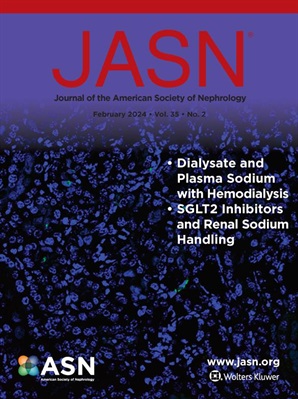anca相关性血管炎中与肾功能和预后相关的肾转录物的鉴定。
IF 9.4
1区 医学
Q1 UROLOGY & NEPHROLOGY
引用次数: 0
摘要
背景:anca相关性血管炎伴肾小球肾炎(AAV-GN)常发展为肾衰竭。然而,用于肾脏预后风险分层的工具仍然有限。现有的方法不能充分捕捉到肾损伤背后的分子复杂性,尽管它具有定制治疗管理的潜在价值。我们探索了肾脏转录组学是否可以识别与肾脏预后相关的分子特征。方法我们从两个多中心生物库中选取199例AAV-GN患者和23例对照组。使用NanoString nCounter对肾活检组织进行分析,评估750个免疫相关基因的表达。我们进行了差异基因表达分析、途径富集分析和免疫细胞浸润评估,以探索肾脏功能和生存的关系。通过lasso惩罚的Cox回归开发了一个12基因预后标记,并与已建立的组织学分类(Berden分类、肾脏风险评分和ANCA肾脏风险评分)进行了稳健的内部验证。结果与对照组相比,saav - gn具有150个差异表达基因的广泛免疫失调,突出了补体激活、免疫细胞募集和激活、tgf - β信号传导和免疫代谢途径。免疫细胞浸润的标志是巨噬细胞、树突状细胞、中性粒细胞和T细胞亚群的增加,反映了广泛的免疫激活。初始eGFR与319个基因的表达相关。12个基因特征(CLU、C3、LTF、FLT1、PLCG2、FES、PRKCD、TXNIP、SLC7A5、PTEN、NRBF2、NFATC1)与肾脏生存的相关性显著高于已建立的组织学分类(校正p值< 0.0001)。几种免疫途径的高表达和低表达(尤其是淋巴细胞运输)与中等表达相比,结果更好。通过对AAV-GN患者肾脏活检组织的转录组学分析,鉴定出150个差异表达的免疫相关基因,并确定了12个与肾脏存活密切相关的基因特征,优于已建立的组织学分类。本文章由计算机程序翻译,如有差异,请以英文原文为准。
Identification of Renal Transcripts Associated with Kidney Function and Prognosis in ANCA-Associated Vasculitis.
BACKGROUND
ANCA-associated vasculitis with glomerulonephritis (AAV-GN) frequently progresses to kidney failure. However, tools for risk stratification of kidney outcomes remain limited. Existing approaches inadequately capture the molecular complexity underlying kidney injury, despite its potential value to tailor therapeutic management. We explored whether kidney transcriptomics could identify molecular signatures linked to kidney outcomes.
METHODS
We included 199 patients with AAV-GN from two multicenter biobanks, and 23 controls. Kidney biopsies were profiled using NanoString nCounter to assess the expression of 750 immune-related genes. We conducted differential gene expression analysis, pathway enrichment analysis, and immune cell infiltration estimation to explore associations with kidney function and survival. A 12-gene prognostic signature was developed via LASSO-penalized Cox regression and compared to established histological classifications (Berden classification, Renal Risk Score, and ANCA Kidney Risk Score) with robust internal validation.
RESULTS
AAV-GN demonstrated extensive immune dysregulation with 150 differentially expressed genes versus controls, highlighting complement activation, immune cell recruitment and activation, TGFβ signaling, and immunometabolism pathways. Immune cell infiltration was marked by increased macrophages, dendritic cells, neutrophils, and T cell subsets, reflecting broad immune activation. Initial eGFR correlated with the expression of 319 genes. A 12-gene signature (CLU, C3, LTF, FLT1, PLCG2, FES, PRKCD, TXNIP, SLC7A5, PTEN, NRBF2, NFATC1) was significantly more strongly associated with kidney survival than were established histological classifications (adjusted p-value < 0.0001). Both high and low expression of several immune pathways (especially lymphocyte trafficking) were associated with better outcomes compared to intermediate expression.
CONCLUSIONS
Transcriptomic analysis of kidney biopsies in AAV-GN identified 150 differentially expressed immune-related genes and led to the development of a 12-gene signature that correlated strongly with kidney survival, outperforming established histological classifications.
求助全文
通过发布文献求助,成功后即可免费获取论文全文。
去求助
来源期刊
CiteScore
22.40
自引率
2.90%
发文量
492
审稿时长
3-8 weeks
期刊介绍:
The Journal of the American Society of Nephrology (JASN) stands as the preeminent kidney journal globally, offering an exceptional synthesis of cutting-edge basic research, clinical epidemiology, meta-analysis, and relevant editorial content. Representing a comprehensive resource, JASN encompasses clinical research, editorials distilling key findings, perspectives, and timely reviews.
Editorials are skillfully crafted to elucidate the essential insights of the parent article, while JASN actively encourages the submission of Letters to the Editor discussing recently published articles. The reviews featured in JASN are consistently erudite and comprehensive, providing thorough coverage of respective fields. Since its inception in July 1990, JASN has been a monthly publication.
JASN publishes original research reports and editorial content across a spectrum of basic and clinical science relevant to the broad discipline of nephrology. Topics covered include renal cell biology, developmental biology of the kidney, genetics of kidney disease, cell and transport physiology, hemodynamics and vascular regulation, mechanisms of blood pressure regulation, renal immunology, kidney pathology, pathophysiology of kidney diseases, nephrolithiasis, clinical nephrology (including dialysis and transplantation), and hypertension. Furthermore, articles addressing healthcare policy and care delivery issues relevant to nephrology are warmly welcomed.

 求助内容:
求助内容: 应助结果提醒方式:
应助结果提醒方式:


